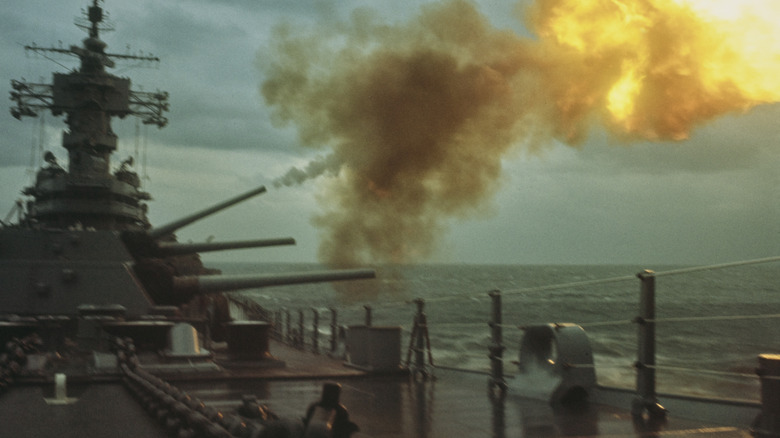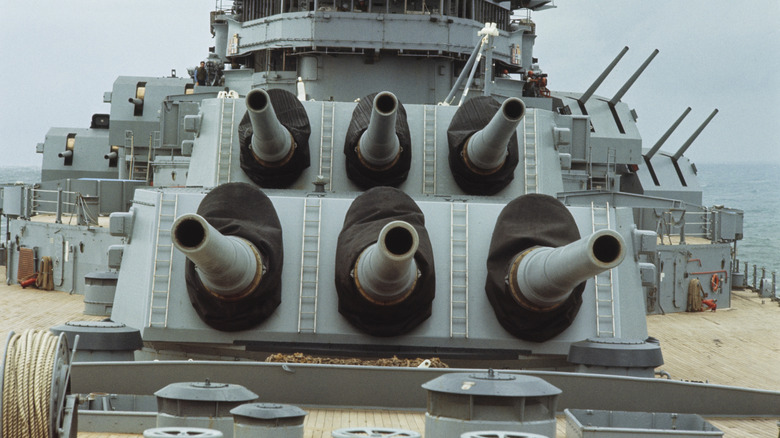Could The US Navy Reactivate Its Decommissioned Battleships?
The United States Navy doesn't use battleships anymore. The last battleships built by the Navy were those of the Iowa class. These gigantic vessels' similarly gigantic guns have been silent since 1991, a year that saw the USS Wisconsin and USS Missouri's contribution to Operation Desert Storm. These vessels had nine 16-inch guns apiece, each of which was capable of blasting out a 2,700-pound shell every thirty seconds. Fearsome primary weapons for a vessel, for sure, which were still bombarding targets half a century after first being commissioned during World War II. Their 1940s heyday was far behind them, though, and the 23-mile maximum range of those guns was nothing compared to the advanced missiles the world was increasingly developing.
The once mighty Iowa class of battleships, of which a quartet were completed — the USS Wisconsin, Missouri, Iowa, and New Jersey – are now fascinating museum exhibits. The USS Iowa, for instance, is now exhibited in San Pedro, California. However, they were not scrapped, and so are potentially available to be overhauled and reactivated. In April 2024, Ryan Szimanski, curator of the Battleship New Jersey Museum, stated on the museum's YouTube channel that "our contract with the navy ... says that they can take the ship over again if they need to."
There are two primary issues surrounding the idea. The first is that it would be impractical and costly, both financially and in terms of resources. The second is that, formidable as they were, they would have rather limited utility in 21st-century warfare. If the need becomes great enough, though, it's both possible and permissible for the U.S. Navy to reactivate its remaining battleships.
The are many roadblocks to reviving battleships
The U.S. Navy has a small but significant mothball fleet, a term which has become a sort of catch-all to encompass the vessels awaiting their final fate, those that are set to be sold for scrap, and those that could yet be called upon. In truly dire straits, even weapons and vehicles that were once decommissioned for being outdated can be brought back into service. Every resource counts in such a situation, and U.S. battleships in particular have proven worthy of being brought back into action when necessary.
In one instance, President Ronald Reagan had resurrected the Iowa class as part of the much-ballyhooed 600-vessel Navy he sought, but they proved to be inadequate in short order. As "The Ships and Aircraft of the U.S. Fleet" author Norman Pulmar puts it in the U.S. Naval Institute's "Proceedings," the issue is that "an Iowa-class battleship's 16-inch guns have a maximum range of 27 miles. This makes the platform irrelevant unless it can be brought close inshore."
These aren't the only weapons that the battleships could wield, as when they were returned to action in the past they were also equipped with a more modern arsenal, including Harpoon and Tomahawk missiles. However, they were not optimized to house great numbers of them. Contemporary destroyers could operate more efficiently and required fewer personnel to do so, further limiting the utility of battleships. Another of the most prominent issues, Pulmar explained, was financial: "During the Reagan buildup, reactivating the four ships totaled about $1.66 billion."
The potential cost of resurrecting these behemoths
In the face of a crisis of sufficient proportions, once outlandish ideas may well emerge as the only path forward, and reactivating decommissioned battleships would certainly count as just that. However, being ready to be toured by museum visitors and being ready for an active tour of duty are two very different concepts indeed. As a curator of the battleship USS New Jersey, Ryan Szimanski, put it, "these guns are significantly different than the types of guns on modern ships, so who knows how much capability they actually have." Plus, even if everything down to the armaments could be put back into working order, ammo is an enormous concern.
Essentials like propellant would also be available in very limited capacity, if at all, as well as oil. Add the complexity of equipping them with modern GPS and other sophisticated systems, and it would be a logistical nightmare to reactivate the vessels. Szimanski explains the sheer scope of the problem: "Each of the times that an Iowa-class battleship has been brought back it has taken at minimum, adjusted for inflation, about $2 billion to reactivate the ship ... with New Jersey it's taken about a year in the yard to reactivate." Though it's certainly possible to reactivate battleships in this way, should an emergency scenario call for it, it would be very complicated and costly indeed to keep that vessel supplied and active. All these factors combined and the uncertainty they cause are why the fate of a decommissioned ship in the U.S. Navy can be so difficult to predict.


